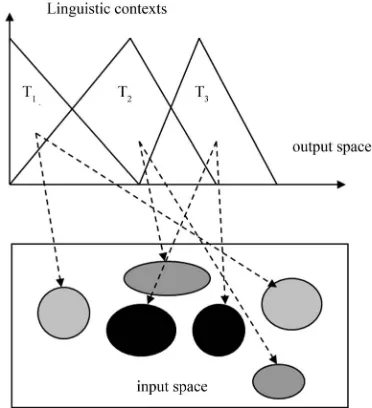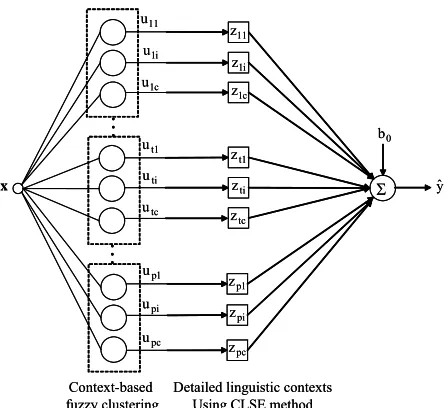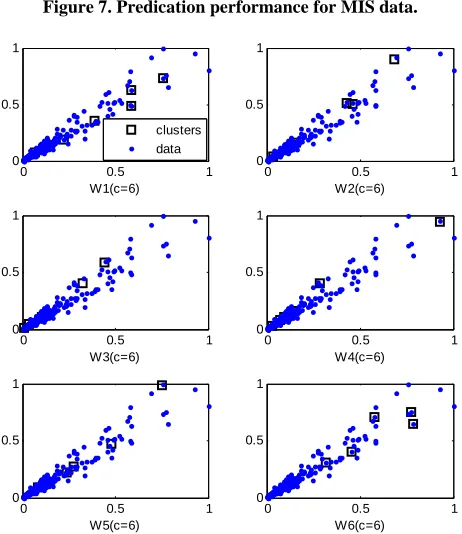A Design of Incremental Granular Network for
Software Data Modeling
Keun-Chang Kwak
Department of Control, Instrumentation and Robot Engineering, Chosun University, Gwangju, Korea (South) Email: kwak@chosun.ac.kr
Received September 6th, 2010; revised September 27th, 2010; accepted October 5th, 2010.
ABSTRACT
In this paper, we propose an incremental method of Granular Networks (GN) to construct conceptual and computa-tional platform of Granular Computing (GrC). The essence of this network is to describe the associations between in-formation granules including fuzzy sets formed both in the input and output spaces. The context within which such rela-tionships are being formed is established by the system developer. Here information granules are built using Con-text-driven Fuzzy Clustering (CFC). This clustering develops clusters by preserving the homogeneity of the clustered patterns associated with the input and output space. The experimental results on well-known software module of Medi-cal Imaging System (MIS) revealed that the incremental granular network showed a good performance in comparison to other previous literature.
Keywords: Incremental Granular Network, Granular Computing, Information Granules, Context-Based Fuzzy Clustering
1. Introduction
Granular Computing (GrC) is a general computation the-ory for effectively using information granules such as classes, clusters, subsets, groups, and intervals to build an efficient computational model for complex applica-tions with huge amounts of data, information and know-ledge [1]. Furthermore, granular computing forms a uni-fied conceptual and computing platform. Yet, it directly benefits from the already existing and well-established concepts of information granules formed in the setting of sets and interval theory, fuzzy sets, rough sets, and sha-dowed sets [2].
In order to form the conceptual and computing plat-form of granular computing, we introduce granular net-work with two types that directly uses the fundamental idea of fuzzy clustering. Based on this network, we also develop and design an incremental granular network that combines linear regression and local granular network [3]. First, we build a standard regression model which could be treated as a preliminary construct capturing the linear part of the data and in this way forming a back-bone of the entire construct. Next, all modeling discrep-ancies are compensated by a collection of rules that be-come attached to the regions of the input space in which the error becomes localized. Here the network is
de-signed by the use of fuzzy granulation realized via con-text-based fuzzy clustering [4]. This clustering technique builds information granules in the form of fuzzy sets and develops clusters by preserving the homogeneity of the clustered patterns associated with the input and output space. The effectiveness of this clustering has been demonstrated on Linguistic Models (LM) [5,6], Radial Basis Function Neural Networks (RBFNNs) [7], and incremental models [8]. These models represented a nonlinear and complex characteristic more effectively than conventional models based on context-free cluster-ing. This paper is organized as follows. Section 2 de-scribes the architecture of granular network with two types and mechanism of context-based fuzzy clustering. In Section 3, we present the design of incremental granular network. This network is applied to software module of well-known Medical Imaging System (MIS) [9] in Section 4. Finally, conclusions are given in Section 5.
2. Granular Network
Let us firstly recall the mechanism of context-based fuzzy clustering. This clustering as an interesting variant of the fuzzy c-means is realized via individual contexts. Each context has clearly defined semantics that can be interpreted as a large negative error, medium negative
by some membership function. The data point in the output space is then associated with the corresponding membership value. Let us introduce a family of the parti-tion matrices induced by the l-th context and denote it by
U(Wl)
c Nik ik k ik
i 1 k 1
(W )l u 0,1 | u wl k and 0 u N
U (1) where wlk denotes a membership value of the k-th datum implied by the l-th context. The underlying objectivefunction is as follows
2 i k N 1 k m ik c 1 i || || u
Q
x v
(2)
where vi denotes the i-th prototype. The Q is minimized under the constraints imposed by (1) as follows
Min Q subject to U(Wl), l = 1,2,, p (3)
The minimization of Q is realized by iteratively
up-dating the values of the partition matrix and the cluster centers. The successive updates of the partition matrix are completed as follows
c 1 j 1 m 2 j k i k k l ik w u v x vx (4)
where i1, 2, , , c k1, 2, , N
Note that uik means the partition matrix induced by the
l-th context. The prototypes are determined as
N 1 k m ik N 1 k k m ik i u u xv (5)
We assume that the fuzzification factor m is 2.0. In the
[image:2.595.325.511.93.297.2] [image:2.595.313.536.98.514.2]design of the granular network, we consider the contexts to be described by triangular membership functions being equally distributed in the error space E with the 1/2 overlap occurring between two successive fuzzy sets. Figure 1 visualizes the example of a blueprint of the incremental granular network for p = 3 and c = 2.
Each context generates a number of induced clusters whose activation levels are afterwards summed up as shown in Figure 2.
Denoting those by 1, , ,2nthe output of the net-work is granular. Assuming the triangular form of the contexts, the result is a triangular fuzzy number E as fol-lows n n 2 2 1
1 W ....W
W
E (6)
[image:2.595.309.536.323.519.2]We denote the algebraic operations by , to emphasize
Figure 1. Concept of context-based fuzzy clustering.
11 u i 1 u c 1 u 1 p u pi u pc u E x 1 W p W 1 p 1 t u ti u tc
u Wt
t Context-based centers Contexts
11 u i 1 u c 1 u 1 p u pi u pc u E x 1 W p W 1 p 1 t u ti u tcu Wt
t Context-based centers Contexts
Figure 2. Architecture of the granular network (case 1).
that the underlying computing operates on a collection of fuzzy numbers. As such, E is characterized by its three parameters that are a modal value, the lower bound, and upper bound.
On the other hand, we develop the advanced granular network with detailed linguistic context as shown in Fig-ure 3. The consequent part is obtained by Constrained Least Square Estimate (CLSE) method as follows
Y Uθ
min
, subject to min(Y)max(Y) (7)
where U and Y denote the activation levels in layer 2 and
11 u i 1 u c 1 u 1 p u pi u pc u x 1 t u ti u tc u
0 b yˆ Context-based fuzzy clusteringDetailed linguistic contexts Using CLSE method
11 z i 1 z c 1 z 1 t z ti z tc z 1 p z pi z pc z 11 u i 1 u c 1 u 1 p u pi u pc u x 1 t u ti u tc u
0 b yˆ Context-based fuzzy clusteringDetailed linguistic contexts Using CLSE method
[image:3.595.61.285.81.285.2] [image:3.595.60.284.315.499.2]11 z i 1 z c 1 z 1 t z ti z tc z 1 p z pi z pc z
Figure 3. Architecture of the granular network (case 2)
Linear Regression z bias Y E x INCRE ME NT AL M O D EL Context-based
clustering fuzzy numbers
(granular information processed)
Figure 4. Overall flow of incremental granular network
3. Design of Incremental Granular Network
The main design process of the incremental granular network is shown in Figure 4 showing how the two functional modules operate. Firstly, we decide upon the granularity of information to be used in the develop-ment of the model such as the number of contexts and the number of clusters formed for each context. The design procedure of incremental granular network is as follows [8].
[Step 1] Design of a linear regression in the input and output space, z = L(x; b) with b denoting a vec-tor of the regression hyperplane, b =[a a0]T. On the basis of the original data set formed is a col-lection of input-error pairs, (xk, ek) where ek =
target-L(xk,a).
[Step 2] Construction of the collection of contexts in the space of error of the regression model E1, E2, , Ep. The distribution of these fuzzy sets is optimized through the use of fuzzy equalization while the fuzzy sets are characterized by trian-gular membership functions with a 0.5 overlap between neighboring fuzzy sets.
[Step 3] Context-based fuzzy clustering completed in the input space and induced by the individual fuzzy sets of context. For “p” contexts and “c” clusters per context, obtained are c*p clusters.
[Step 4] Summation of the activation levels of the clus-ters induced by the corresponding contexts and their overall aggregation through weighting by fuzzy sets of the context leading to the triangular fuzzy number of output, E = F (x; E1, E2, , Ep) where F denotes the overall transformation
real-ized by the incremental granular network. Fur-thermore note that we eliminated eventual sys-tematic shift of the results by adding a numeric bias term.
[Step 5] The result of the incremental granular network is then combined with the output of the linear part. The result is a shifted triangular number Y, Y = z E.
4. Experimental Results
In order to evaluate the performance of the incremental granular network for data modeling in software engi-neering, we applied to well-known Medical Imaging System (MIS) subset of 390 software modules written in Pascal and FORTRAN [9]. These modules consist of approximately 40,000 lines of code. We use 11 system input variables such as, LOC, CL, TChar, TComm, MChar, DChar, N, Nh, NF, V(G), and BW, The output variable to be predicted is “Changes”. The training and testing data set are randomly selected by 60%-40%.
The experiments are performed by 10 runs. The train-ing data set is used for model construction, while the test set is used for model validation. Thus, the resultant model is not biased toward the training data set and it is likely to have a better generalization capacity to new data. We obtained the best case (m = 3.0, p = c = 6), while varying the number of cluster ( ) and fuzzifica-tion factor (m = 1.5, 2.0, 2.5, 3.0).
6 2 p
-40 -30 -20 -10 0 10 20 0
0.2 0.4 0.6 0.8 1
error
d
egr
ee of
m
em
ber
s
hi
[image:4.595.56.290.82.264.2]p
Figure 5. Contexts obtained from linear regression error (Case 1).
0 5 10 15 20 25 30 35 40
-50 -40 -30 -20 -10 0 10 20 30
error
[image:4.595.308.538.87.263.2]zpc
Figure. 6 Consequent parameters (Case 2).
used six contexts and six clusters in each context for context-based fuzzy clustering. Although the LM has a structured knowledge representation in the form of fuzzy if-then rules, it lacked the adaptability to deal with non-linear model. Moreover, we constructed the RBFN based on six contexts and six clusters in the same manner. Here learning rate is 0.0001 and the number of epoch is 1000. As listed in Table 1, we can recognize that the proposed method (IGN with two cases) showed a good perform-ance in comparison to linguistic model and RBFNNs based on context-based fuzzy clustering.
5. Conclusions
We presented the design of the incremental granular network for software data of medical imaging system. This network is adopted a construct of a linear regression as a first-principle global model, refine it through a series
0 50 100 150 200 250
-20 0 20 40 60 80 100
num of data
C
ha
nges
model output actual output
Figure 7. Predication performance for MIS data.
0 0.5 1
0 0.5 1
W1(c=6) clusters data
0 0.5 1
0 0.5 1
W2(c=6)
0 0.5 1
0 0.5 1
W3(c=6)
0 0.5 1
0 0.5 1
W4(c=6)
0 0.5 1
0 0.5 1
W5(c=6)
0 0.5 1
0 0.5 1
[image:4.595.308.539.274.541.2]W6(c=6)
[image:4.595.57.287.306.488.2]Figure 8. Distribution of clusters and input data (DChar, N).
Table 1. Performance comparison.
Prediction Performance
Methods Train_RMSE Check_RMSE
LM [4] 6.266 7.981
RBFN [6] 6.631 7.772
IGN(Case1) 4.626 6.624
IGN(Case2) 3.770 6.532
[image:4.595.307.539.587.659.2]two essential modeling structures that are combined lin-ear regression and local granular network. The experi-mental results revealed that the increexperi-mental granular network outperformed the previous works. The granular networks used in this paper can be applied to intelligent data analysis, nonlinear system modeling, adaptive hy-permedia, e-commerce, and intelligent interfaces.
REFERENCES
[1] W. Pedrycz, A. Skowron and V. Kreinovich, “Handbook of Granular Computing,” John Wiley & Sons, Hoboken, 2008.
[2] W. Pedrycz and F. Gomide, “Fuzzy Systems Engineering: Toward Human-Centric Computing,” Wiley-Interscience, Hoboken, 2007.
[3] M. Y. Lee and K. C. Kwak, “An Incremental Granular Network for Data Modeling in Software Engineering,” 2010 4thInternational Conference on New Trends in In-formation Science and Service Science (NISS), Gyeongju, Korea , May 2010, pp. 495-498.
[4] W. Pedrycz, “Conditional Fuzzy C-Means,” Pattern Recognition Letters, Vol. 17, No. 6, May 1996, pp. 625-632.
[5] W. Pedrycz and A. V. Vasilakos, “Linguistic Models and Linguistic Modeling,” IEEE Transactions on Systems, Man and Cybernetics-Part C, Vol. 29, No. 6, 1999, pp. 745-757.
[6] W. Pedrycz and K. C. Kwak, “Linguistic Models as Framework of User-Centric System Modeling,” IEEE Transactions on Systems, Man and Cybernetics-Part A, Vol. 36, No. 4, 2006, pp. 727-745.
[7] W. Pedrycz, “Conditional Fuzzy Clustering in the Design of Radial Basis Function Neural Networks,” IEEE Transactions on Neural Networks, Vol. 9, No. 4, 1999. pp. 745-757.
[8] W. Pedrycz and K. C. Kwak, “The Development of In-cremental Models,” IEEE Transactions on Fuzzy Systems, Vol. 15, No. 3, 2007, pp. 507-518.
[9] S. K. Oh, W. Pedrycz and B. J. Park, “Self-Organizing Neurofuzzy Networks in Modeling Software Data,” Fuzzy
Sets and Systems, Vol. 145, No. 1, July 2004, pp.
165-181.


